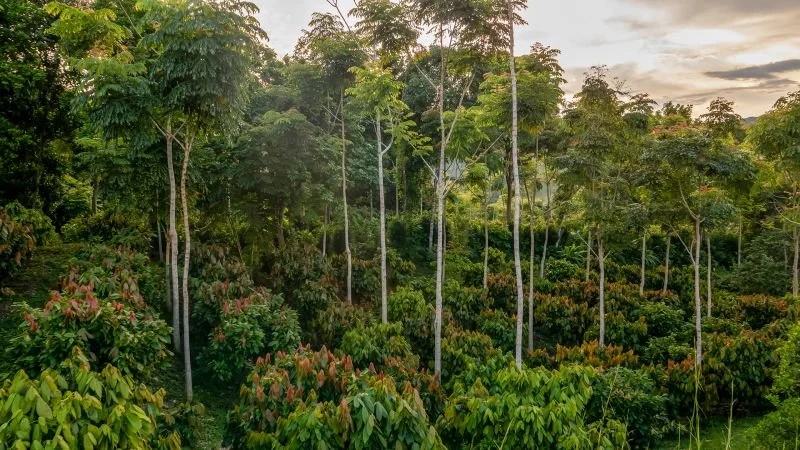What is Agroforestry?
When people in the U.S. think of farming, we often picture massive fields of the same plant. Acres upon acres of rows of mass-produced crops. As someone who grew up in southern Minnesota, farm fields are an incredibly common part of my life.
After living in a small farming town I have seen and learned a lot about monoculture and the hurdles in farming that way. It’s a massive undertaking, both in raw resources and technology required to keep things going. Still, monoculture may be good at yielding large amounts of crops, but it’s hardly the most efficient way to make food happen for the masses.
Agroforestry takes a considerably different approach. It’s a basic concept: Incorporate trees and a variety of yielding crops into a farm field to increase the effectiveness of the land to produce food.
Not only does Agroforestry potentially increase yields from individual plants, it can also increase the overall health of the ecosystem we are trying to sustain ourselves on. Trees have been known to be extremely beneficial to nurturing healthy environments, and the same can definitely be said for farming in many ways.
How does Agroforestry impact the Environment?
Actually, using trees in farmland is great not only for reducing soil nutrients lost on our crop fields, it’s great for reducing the carbon emissions let off by the farm. While it may not be perfect and the reduction varies greatly on the size and setup of the farm, by and large it helps keep the overall environment in a healthier balance.
At least, healthier than removing acres of natural habitat to farm fields of the same plant anyway. We can take this a step further and introduce native grasses, flora, and foraging plants to help keep a diversely profitable and increasingly sustainable environment while also producing a larger variety of food.
It even goes beyond carbon emissions. You can draw beneficial wildlife by controlling which plants you bring in, as well as potential for mycological networks increasing the overall health of the soil and you have a powerhouse way to farm while dramatically reducing your impact on the environment.
Trees also accommodate shadier crops, and can yield nuts and fruits as produce or feed for livestock and animals. It even provides firewood for the farmer. That last part can greatly increase the carbon emissions of the farm, but burning wood is hard to avoid. Having fields of trees to sustain local firewood can be far less impactful than transporting treated wood in the long run, making even this angle hard to argue with.
Types of Agroforestry:
While Agroforestry is a broad term and describes a huge array of ways to shepherd our environment for food, there are a few names for specific practices. These practices vary based on the type of environment, size of the farm, and even what types of food you want your farm to produce. These farms can produce plants, trees for wood production, livestock and even fish from streams or ponds.
Alley Cropping - A simple method of planting trees in rows with crops planted in the alleys between the rows of trees. This can provide shade, reduction in wind damage, increased soil health, and even yield products from the trees themselves.
Forest Farming(Multi-Story Cropping) - Farming food beneath a managed forest canopy. Largely used for forageables, mushrooms, and specific heavy-shaded crops. More involved as a forest is much harder to maintain balance due to increased biodiversity. Still, these farms absolutely exist and can still be fairly profitable.
Silvopasture - A very involved method of introducing grazing animals into the ecosystem to maintain a healthy balance. Can increase yields and diversify both long and short-term income. Can increase wildlife diversity in the area, and constant grazing in a balanced ecosystem keeps soil incredibly healthy.
Riparian Forest Buffers - Create an unmanaged ecosystem lining rivers or streams, with a layer of managed forestry ecosystem past it to help reduce runoff from the agricultural process into watersheds. Basically, the ecosystem between the farm and the river or stream becomes beneficial both to the farm and the stream. Fewer contaminates get into the river, while the farmland beyond sees the benefit of healthier soil and maintained forests that can yield their own short-term income.
Windbreaks - Exactly as it sounds. Lines of trees planted with the entire goal of reducing wind damage across the entire farm. This not only shelters the animals from extreme temperatures, it also ensures the soil does not lose it’s nutrients or moisture from heavy winds. Farmers may plant staggered lines and use the trees for firewood, or plant them for harvest to sell as wood products.
Agroforestry - A Method of the Past, Present, and Future
While there are many benefits to Agroforestry, this is not the only method of food production humans are learning to utilize to reduce their impact on the environment. It is one of the few methods of “traditional” agriculture that really takes on the role of stewards of the land. Not just for the food we eat, but for the entire ecosystem around us to thrive so we may live in symbiosis with it.
Traditional monoculture is not going away any time soon, but I can say that even traditional monoculture is starting to adopt some methods of Agroforestry even if it’s not across the entire farm. While we push towards the future and learn more about agriculture, it seems this surprisingly old way of farming has a lot going for it.
It almost begs the question: Could Agroforestry make Monoculture a thing of the past?




